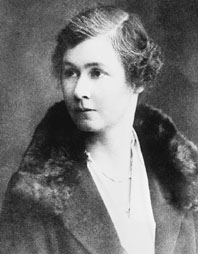

 | Page 283 |  |
success. It also marked the end of their involvement with the Maya. Both Catherwood and Stephens pursued their careers in other directions, either alone or as partners, such as in the Panama railroad project in 1849.
Stephens died in 1852, his life shortened by the complications of various tropical diseases. Catherwood died in 1854, one of three hundred passengers to go down with the S.S. Arctic in the middle of the Atlantic Ocean.
See also
(1888–1985)
Born in London and educated in Eastbourne, Caton-Thompson was from an upper-middle-class family, and the early death of her father made her financially independent for the whole of her life. Until World War I she enjoyed an active social life in London and the country, and she traveled, describing her trips to Italy and Egypt during this time as the source of her later interest in archaeology.

Gertrude Caton-Thompson
(Hulton Getty)
In 1917 she was employed by the Ministry of Shipping and promoted to a senior secretarial post in which she attended the Paris Peace Conference. She declined a permanent appointment in the civil service and in 1921, aged 33, began her archaeological studies under Margaret Murray, Dorothea Bate and Sir w. m. flinders petrie at University College London. Caton-Thompson joined Petrie’s excavations at abydos in Upper Egypt in 1921 and Murray’s excavations in Malta in 1922. She spent the next year at Newnham College, Cambridge, attending courses in prehistory, geology, and anthropology.
In 1924 she returned to Egypt to work with Petrie and Brunton at Qau. While they investigated the cemetery, Caton-Thompson excavated the predynastic settlement site at Hemamieh and discovered the Badarian civilization. With Guy Brunton she wrote The Badarian Civilization (1928).
In 1925, accompanied by the Oxford geologist Elinor Gardner, Caton-Thompson began the Archaeological and Geological Survey of the northern Fayum, one of the first interdisciplinary surveys on settlement patterns and sequences in Egypt. Between 1927 and 1928 she excavated and worked with Gardner in northwestern Egypt on the desert margins of Lake Fayum, discovering two unknown Neolithic cultures that were later proven to be part of the Khartoum Neolithic. Their findings were published in The Desert Fayum (1934).
In 1929 Caton-Thompson was invited by the British Association for the Advancement of Science to investigate the great monumental ruins at great zimbabwe in southern Africa. She confirmed that these ruins belonged to an indigenous African culture and dated them to the eighth or ninth centuries a.d., producing evidence of Zimbabwe’s links with Indian Ocean trade. One of her assistants on this project was the young Oxford graduate kathleen kenyon. Caton-Thompson’s conclusions were published in The Zimbabwe Culture (1931). In 1930 she and Elinor Gardner collaborated again on excavations of prehistoric sites at the Kharga Oasis. These were the first Saharan oasis sites to be excavated, and the first in a large research program on the investigation of the Paleolithic of
 |  |